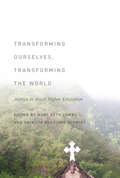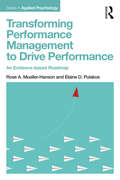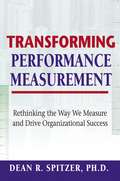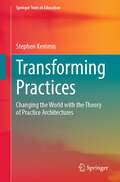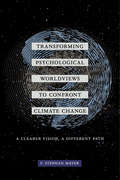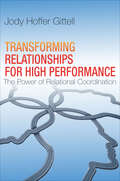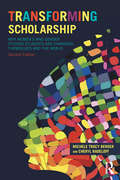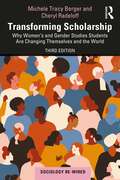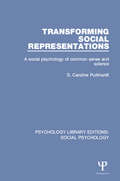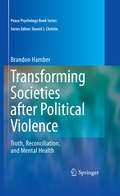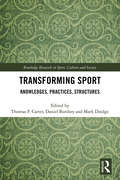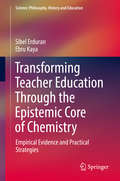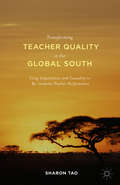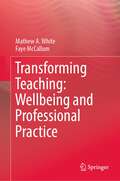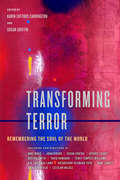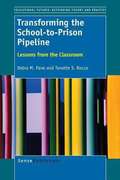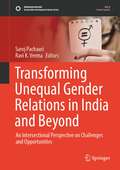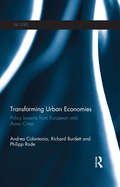- Table View
- List View
Transforming Ourselves, Transforming the World: Justice in Jesuit Higher Education
by Mary Beth Combs Patricia Ruggiano SchmidtTransforming Ourselves, Transforming the World is an insightful collection that articulates how Jesuit colleges and universities create an educational community energized to transform the lives of its students, faculty, and administrators and to equip them to transform a broken world. The essays are rooted in Pedro Arrupe’s ideal of forming men and women for others and inspired by Peter-Hans Kolvenbach’s October 2000 address at Santa Clara in which he identified three areas where the promotion of justice may be manifested in our institutions: formation and learning, research and teaching, and our way of proceeding.Using the three areas laid out in Fr. Kolvenbach’s address as its organizing structure, this stimulating volume addresses the following challenges: How do we promote student life experiences and service? How does interdisciplinary collaborative research promote teaching and reflection? How do our institutions exemplify justice in their daily practices? Introductory pieces by internationally acclaimed authors such as Rev. Dean Brackley, S.J.; David J. O’Brien; Lisa Sowle Cahill; and Rev. Stephen A. Privett, S.J., pave the way for a range of smart and highly creative essays that illustrate and honor the scholarship, teaching, and service that have developed out of a commitment to the ideals of Jesuit higher education. The topics covered span disciplines and fields from the arts to engineering, from nursing to political science and law. The essays offer numerous examples of engaged pedagogy, which as Rev. Brackley points out fits squarely with Jesuit pedagogy: insertion programs, community-based learning, study abroad, internships, clinical placements, and other forms of interacting with the poor and with cultures other than our own. This book not only illustrates the dynamic growth of Jesuit education but critically identifies key challenges for educators, such as: How can we better address issues of race in our teaching and learning? Are we educating in nonviolence? How can we make the college or university “greener”? How can we evoke a desire for the faith that does justice?Transforming Ourselves, Transforming the World is an indispensable volume that has the potential to act as an academic facilitator for the promotion of justice within not only Jesuit schools but all schools of higher education.
Transforming Pedagogies Through Engagement with Learners, Teachers and Communities (Education in the Asia-Pacific Region: Issues, Concerns and Prospects #57)
by Dat Bao Thanh PhamThis book identifies three types of influential forces that pose challenges to innovations: socio-cultural dynamics, teacher individuality, and local circumstances. It uses languages, cultural traits, and intellectual heritages in the Asia-Pacific region as an example to show the resistance to Western-based pedagogies due to disparities between the innovations and these local heritages. It reveals personal and professional values that teachers hold and how these values, while seemingly supporting creative ideologies, happen to prevent them from incorporating innovations in their practices. The book discusses how informal educational activities and services that a society possesses could impede pedagogical innovations. There is, therefore, a need for institutions and educators to develop a positive relationship between these phenomena and teaching innovations.
Transforming Performance Management to Drive Performance: An Evidence-based Roadmap (Applied Psychology Series)
by Elaine D. Pulakos Rose A. Mueller-HansonRecently a revolution has taken place in organizations around the world to transform their performance management systems from burdensome chores into a valuable business practices. Many high-profile companies have announced they are getting rid of the dreaded performance reviews and replacing them with ongoing coaching and feedback. Although these cases are inspiring other organizations to contemplate change, many are left with more questions than answers. While many fads and quick fixes have been proposed to answer these questions, little research exists to support them. This book provides a practical and evidence-based guide for building a performance management approach that actually improves performance. It cuts through the hype and gives actionable advice, useful tools, and real-world examples for organizations to build the business case for change, plan the transformation, design the new system, and implement the change effectively. Featuring research findings as well as concrete strategies from organizations that have proven successful, this book provides a roadmap for meaningful change. It will be of interest to professionals and scholars interested in evidence-based performance management and the challenges facing organizations.
Transforming Performance Measurement: Rethinking the Way We Measure and Drive Organizational Success
by Dean SpitzerPerformance improvement thought leader Dean Spitzer explains why performance measurement should be less about calculations and analysis and more about the crucial social factors that determine how well the measurements get used.Transforming Performance Measurement presents a breakthrough approach that will not only significantly reduce those dysfunctions, but also promote alignment with business strategy, maximize cross-enterprise integration, and help everyone to work collaboratively to drive value throughout your organization. Spitzer&’s "socialization of measurement" process focuses on learning and improvement from measurement, and on the importance of asking such questions as:How well do our measures reflect our business model? How successfully are they driving our strategy? What should we be measuring and not measuring? Are the right people having the right measurement discussions? Performance measurement is a dynamic process that calls for an awareness of the balance necessary between seemingly disparate ideas: the technical and the social aspects of performance measurement. This book gives you assessment tools to gauge where you are now and a roadmap for moving, with little or no disruption, to a more "transformational" and mature measurement system.The book also provides 34 TMAPs, Transformational Measurement Action Plans, which suggest both well-accepted and "emergent" measures (in areas such as marketing, human resources, customer service, knowledge management, productivity, information technology, research and development, costing, and more) that you can use right away. Transforming Performance Measurement tells you not only what to measure, but how to do it -- and in what context -- to make a truly transformational difference in your enterprise.
Transforming Practices: Changing the World with the Theory of Practice Architectures (Springer Texts in Education)
by Stephen KemmisThis textbook shows how people can and do transform the world through transforming their practices and the practice architectures that shape them, and contributes to contemporary practice theory. It provides an authoritative, comprehensive, and contemporary account of the theory of practice architectures, illustrated through examples drawn from years of research by participants in the Pedagogy, Education, and Praxis international research network from Australia, New Zealand, Finland, Norway, Sweden, the Netherlands, Colombia, and the Caribbean. Its content provides a variety of resources for researchers who are new to research using the theory of practice architectures. It includes tables to assist with the analysis of practices, and provides clear examples to aid understanding and application. This textbook provides readers with a thorough grounding in the theory and ways the theory of practice architectures has been used in investigations of social and educational practice.
Transforming Psychological Worldviews to Confront Climate Change: A Clearer Vision, A Different Path
by F. Stephan MayerIn the continuing debate of how to confront the challenges of climate change, individuals, advocacy groups, and political parties in the United States offer arguments and solutions based on economic and political viewpoints. But what if we are beginning from a distorted view? In this book, F. Stephan Mayer argues that our psychological representation of the world is at the heart of the underlying causes of climate change. Mayer posits that we need to change the way we see the world if we are to effectively take a new course of action to address this threat. Through an alternative worldview based on Aldo Leopold’s concept of land ethic, Mayer furthers the conversation by promoting a clearer vision of our relationship to nature and how it leads to a different path directed toward environmental sustainability. Based on over 20 years of psychological research examining the impact of the land ethic on pro-environmental behavior and personal well being, Mayer’s accessible tone invites readers to place their worldview within a broader framework, draw connections to their lives, and spark ideas of next steps that individuals and groups can take to transition to this alternative worldview and rectify this situation.
Transforming Relationships for High Performance: The Power of Relational Coordination
by Jody Hoffer GittellWhether from customers, supply-chain partners, policymakers, or regulators, organizations in virtually every industry are facing calls to do more with less. They are feeling compelled to provide higher-quality outcomes, more rapidly, at a lower cost. This book offers a road-tested approach for delivering these outcomes through positive organizational change. Its message comes just in time, for too many companies have gone the way of low-road strategies, such as cutting pay and perks, and working harder not smarter. Drawing on her path-breaking research, Jody Hoffer Gittell reveals that high performance is fundamentally relational--rooted in both human and social capital. Based on this insight, she provides a unique model that will help companies to build meaningful relationships among colleagues, develop smarter work processes, and design organizational structures fit for today's pressure test. By following four organizations on their change journeys, she illustrates how "relational coordination" unfolds in real-world settings. Tools for change guide readers as they learn how to implement this new model in their own workplaces.
Transforming Scholarship: Why Women's and Gender Studies Students Are Changing Themselves and the World
by Michele Tracy Berger Cheryl L RadeloffTransforming Scholarship is a user-friendly work of practical guidance and inspiration for supporting a student's interest in a Women's Studies degree. Berger and Radeloff use empirical evidence to help students with the major barriers they face when exploring Women's Studies: the negative response a student often faces when announcing to the world that he or she is interested in Women’s Studies; and the perceived lack of employment and career options that supposedly comes with graduating with a Women's Studies degree. This book will support students to think critically about what they know, how to demonstrate what they know, and how to prepare for life both personally and professionally after the degree. Transforming Scholarship is a practical guide for students interested in women’s and gender studies that targets advanced undergraduates who have a firm connection to the discipline. This book is ideal for women’s and gender capstone courses, and for those who have finished their degree and need a resource to assist in conceptualizing the answers to the question "What’s next?" This second edition of Transforming Scholarship focuses on areas that undergraduates might want integrate into their women’s and gender studies education: study abroad, civic engagement projects, internships, independent studies, and honors theses. It includes exercises to help flesh out talents, passions, and skills, and how to link them to employment, information about the diversity of employment opportunities (and further professional training) available, and a plan to help prepare for graduation. It also delves into how to live a feminist life after graduation, including activism after college, building and sustaining feminist communities, and feminist parenting. The authors have also added new "Point of View" boxes throughout the book, where scholars focus on contemporary issues and deepen a student’s understanding of the organizations and individuals fighting to end sexist oppression.
Transforming Scholarship: Why Women's and Gender Studies Students Are Changing Themselves and the World (ISSN)
by Michele Tracy Berger Cheryl RadeloffTransforming Scholarship offers an essential guide to one of the most richly rewarding yet often under-appreciated academic majors: Women's and Gender Studies. This fully updated and revised third edition answers the question of what you can do with a women’s and gender studies degree with resounding authority. Chapters include exercises and valuable point-of-view segments with recent graduates and academics to help students realize their many talents and passions and how these may be linked to future professional opportunities. Students are also encouraged to reflect on the ways in which their efforts in the classroom can be translated into a life guided by feminism, civic engagement, and activism with updates such as: A focus on activism that resulted from socio-political movements in the 2010s–2020, such as #BlackLivesMatter (BLM) and the #MeToo Movement; An examination of the impact of COVID-19 on the academic and socio-cultural environment and career opportunities for graduates; An exploration of increased acceptance of social justice and feminist perspectives; Highlighting of intersectional identities of WGST students and faculty. Transforming Scholarship is an ideal counterpart and companion for capstone courses in women’s and gender studies, and for those who have finished their degree and are looking for invaluable advice while pondering, "What’s next?"
Transforming Scholarship: Why Women's and Gender Studies Students Are Changing Themselves and the World (Sociology Re-Wired)
by Michele Tracy Berger Cheryl RadeloffTransforming Scholarship offers an essential guide to one of the most richly rewarding yet often under-appreciated academic majors: Women's and Gender Studies. This fully updated and revised third edition answers the question of what you can do with a women’s and gender studies degree with resounding authority. Chapters include exercises and valuable point-of-view segments with recent graduates and academics to help students realize their many talents and passions and how these may be linked to future professional opportunities. Students are also encouraged to reflect on the ways in which their efforts in the classroom can be translated into a life guided by feminism, civic engagement, and activism with updates such as: A focus on activism that resulted from socio-political movements in the 2010s–2020, such as #BlackLivesMatter (BLM) and the #MeToo Movement; An examination of the impact of COVID-19 on the academic and socio-cultural environment and career opportunities for graduates; An exploration of increased acceptance of social justice and feminist perspectives; Highlighting of intersectional identities of WGST students and faculty. Transforming Scholarship is an ideal counterpart and companion for capstone courses in women’s and gender studies, and for those who have finished their degree and are looking for invaluable advice while pondering, "What’s next?"
Transforming Social Action into Social Change: Improving Policy and Practice
by Shana CohenCohen offers a new framework for analyzing social projects and local social activism. Rather than look at how single projects are designed and managed to evaluate their impact, the approach calls for analyzing fields of social action: policy and politics, institutional behavior, social networks among policymakers and practitioners, and availability of funding and other resources. Combined, they affect the conceptualization of a social problem and the design and practice of social intervention. More broadly, through circumscribing the range of thinking about social problems, they delimit possibilities to generate social change. Analyzing fields also allows for linking macro-level trends in areas like policy to decision-making within individual organizations and the effectiveness of projects at instigating the desired transformation in individual and collective behavior. Working together, policymakers, individual activists, nonprofit organizations, and staff in public institutions like schools and hospitals can critique and alter fields to challenge more effectively social problems. This collaboration, in turn, affects how social policies are designed and, ultimately, the politics of social change.
Transforming Social Representations: A social psychology of common sense and science (Psychology Library Editions: Social Psychology)
by S. Caroline PurkhardtCommon sense, by definition, is familiar to us all. Science, for some of us, is more remote, yet it is not always clear what the connections are between these two ways of seeing the world. In this title, originally published in 1993, the author explores several related themes in social psychology to elucidate the way we understand the social construction of knowledge and the means by which we change social reality. From the perspective of a critique of social representations theory, the author argues that this necessitates a change of viewpoint from the individualistic and mechanistic assumptions of Cartesian science to the social and evolutionary perspective of a Hegelian framework. This not only emphasizes the cultural and historical dimensions of social phenomena but also illuminates the social and dynamic nature of individuals. As a consequence, the discipline of social psychology must itself be transformed, recognizing the active participation of scientists in the social construction of scientific knowledge. This title will be of interest to those working in social psychology, history and philosophy of science, and sociology.
Transforming Societies after Political Violence
by Brandon HamberTransforming Societies after Political Violence explores the relationship between the individual and the political and social contexts in which victims or survivors of violence find themselves. The book delves into the complex interplay between individual psychological processes and macro-political interventions such as truth commissions. During times of political transition, it is vital that there exists a bridge between what takes place at the national or political level and the personal experience of the victim or survivor of political violence. This is where the work in and around transitional justice processes--undertaken by policymakers, survivors themselves, and those working to assist or support them--can be of great benefit. Supporting victims, once they are ready, to be active agents within their environment is critical. In short, the book demonstrates how dealing with the legacy of individual experience of violence and collective processes of peacebuilding can be better integrated to make a lasting peace in societies in transition.
Transforming Society: Strategies for Social Development from Singapore, Asia and Around the World (Routledge Contemporary Southeast Asia Series)
by Ngoh Tiong Tan with Steve Chan, Kalyani Mehta and David AndroffSocial change affects all quarters of life and human society whether in individual neighbourhoods, communities or nations, or in the world as a whole – encompassing many issues of gender, age, social class and ethnicity. This book examines both the conceptual as well as operational aspects of social transformation and social development. It examines societal transformation at the individual, group, community, national and international levels using a range of case studies from Singapore, Asia and around the world. The four parts of this book highlight the challenges of social development; issues concerning workforce and migration; welfare, women and social care; as well as, community development and capacity building. Social development and social transformation are presented as intertwined concepts that affect citizens in profound ways from social care to social well-being, construction of social relationship as well as community life, capacity building and nation building.
Transforming Sport: Knowledges, Practices, Structures (Routledge Research in Sport, Culture and Society)
by Daniel Burdsey Thomas F. Carter Mark DoidgeSport sociology has a responsibility to engage critically with the accepted wisdom of those who govern and promote sport. This challenging collection of international research is a clear call for enacting the transformation of sport. The contributing authors argue that it is not enough to merely advocate for change. Rather, they insist that scholars need to take an active political stance when conducting research with the explicit purpose of attempting to transform the practices, structures, and the ways in which knowledge is produced about sport. By exposing and challenging the power relations which perpetuate discrimination and inequality within sport, it becomes possible to catalyse wider societal changes. Drawing on a diversity of topics including sport for development and peace, transnational feminism, disability sport, refugees and football activism, FIFA, the Olympics, sports journalism and digital sports media, this book makes a case for sport sociology as an agent of positive change in the hierarchies and institutional structures of contemporary sport. Transforming Sport: Knowledges, Practices, Structures provides valuable insights for all students and scholars interested in the sociology of sport and its transformative potential.
Transforming Subjectivities: Studies in Human Malleability in Contemporary Times (Routledge Studies in the Sociology of Work, Professions and Organisations)
by Kerstin Jacobsson Cecilia Hansen LöfstrandThis volume examines the transformation of subjectivities following contemporary societal trends with regulatory and administrative authorities targeting human subjectivity with the aim to transform it. It addresses the malleability of human subjectivity through rich qualitative analyses of how different governing attempts are received by the subjects themselves. While the scholarship on governmentality has so far produced an enormously useful body of literature on the ‘how’ aspect of governing, this book suggests that it has been prone to overestimate the degree to which our subjectivities are open to change. Combining ethnographic sensitivity with more traditional governmentality perspectives allows us to explore how governing attempts ‘land’ in the terrain targeted—human subjectivity—in actual social contexts, under specific forms of governing and rationality. In doing so, the book makes a distinctive contribution to a second generation of governmentality studies. It will appeal to social scientists with interests in governance, governmentality, social policy and the sociology of work.
Transforming Teacher Education Through the Epistemic Core of Chemistry: Empirical Evidence and Practical Strategies (Science: Philosophy, History and Education)
by Sibel Erduran Ebru KayaThis book synthesizes theoretical perspectives, empirical evidence and practical strategies for improving teacher education in chemistry. Many chemistry lessons involve mindless “cookbook” activities where students and teachers follow recipes, memorise formulae and recall facts without understanding how and why knowledge in chemistry works. Capitalising on traditionally disparate areas of research, the book investigates how to make chemistry education more meaningful for both students and teachers. It provides an example of how theory and practice in chemistry education can be bridged. It reflects on the nature of knowledge in chemistry by referring to theoretical perspectives from philosophy of chemistry. It draws on empirical evidence from research on teacher education, and illustrates concrete strategies and resources that can be used by teacher educators. The book describes the design and implementation of an innovative teacher education project to show the impact of an intervention on pre-service teachers. The book shows how, by making use of visual representations and analogies, the project makes some fairly abstract and complex ideas accessible to pre-service teachers.
Transforming Teacher Quality in the Global South: Using Capabilities and Causality to Re-examine Teacher Performance
by Sharon TaoA common story of teachers from the Global South portrays them as deficient, unreliable and unprofessional. However, this book uses an innovative Capability Approach/Critical Realist lens to reveal the causal links between teachers' constrained capabilities and their 'criticised' behaviours and offer nuanced, creative strategies for improvements.
Transforming Teaching: Wellbeing and Professional Practice
by Mathew A. White Faye McCallum<p>This book focuses on evidence-based approaches to teaching from a wellbeing lens. It addresses significant issues in wellbeing education in initial teacher education, teacher, and leaders’ wellbeing during, schooling disruption and in teaching more broadly through innovative multi-disciplinary research.<p> <p>This book addresses how to lead wellbeing within schools, and showcases a unique strategy adopted by an Australian university to integrate a wellbeing framework throughout initial teacher education preparation.<p> <p>It explores different evidence-based models of wellbeing education and focuses on the significance of culture and context. Readers can learn how teachers can integrate evidence-based wellbeing approaches to transform their professional practice and promote student flourishing and academic growth.<p>
Transforming Terror: Remembering the Soul of the World
by Susan Griffin Karin Lofthus CarringtonThis inspired collection offers a new paradigm for moving the world beyond violence as the first, and often only, response to violence. Through essays and poetry, prayers and meditations, Transforming Terror powerfully demonstrates that terrorist violence--defined here as any attack on unarmed civilians--can never be stopped by a return to the thinking that created it. A diverse array of contributors--writers, healers, spiritual and political leaders, scientists, and activists, including Desmond Tutu, Huston Smith, Riane Eisler, Daniel Ellsberg, Amos Oz, Fatema Mernissi, Fritjov Capra, George Lakoff, Mahmoud Darwish, Terry Tempest Williams, and Jack Kornfield--considers how we might transform the conditions that produce terrorist acts and bring true healing to the victims of these acts. Broadly encompassing both the Islamic and Western worlds, the book explores the nature of consciousness and offers a blueprint for change that makes peace possible. From unforgettable firsthand accounts of terrorism, the book draws us into awareness of our ecological and economic interdependence, the need for connectedness, and the innate human capacity for compassion.
Transforming The School-to-Prison Pipeline: Lessons From The Classroom (Educational Futures #61)
by Tonette S. Rocco Debra M. PaneThis book was written during a time of growing upheaval and disagreement about how America should educate its students, particularly those who are poor, diverse, and failing school. Dominant educational research, newspapers, and popular movies such as "Waiting for Superman" continually fuel public debates about whether our 21st century schools provide justice for all, decrease the achievement gap, and leave no child behind. <p><p> However, even though one of teachers' greatest concerns and why many leave the profession, classroom discipline is rarely brought to the forefront of discussion. As a result, public discourse does not get into what actually happens during disciplinary moments that ultimately leads to the disproportional tracking of particular students into exclusionary school disciplinary consequences, which funnels an underclass of students into the school-to-prison pipeline. <p> This book is a scholarly study, presented here as a readable story, and practical guide for walking teachers, administrators, and teacher education programs through the process of transforming traditional ways of thinking about classroom discipline and teaching in order to create student-centered, creative, non-punitive classrooms that authentically engage the most alienated and oppressed students in our schools and society.
Transforming Unequal Gender Relations in India and Beyond: An Intersectional Perspective on Challenges and Opportunities (Sustainable Development Goals Series)
by Saroj Pachauri Ravi K. VermaThis book offers a unique intersectional perspective on gender equality, SDG5. It presents an intersection of gender with caste, class, region, ethnic and sexual identities, and other structural drivers of inequalities in various development sectors. It presents case studies and empirical findings from development practice and policymaking and highlights the challenges to implementing SDG5 in practice. It discusses policies to promote gender equality and prevent violence against women and girls, and women in decision-making and leadership positions. The chapters reinstate that gender equality is possible only if unequal gender norms are transformed to recognize women and girls as independent economic entities and not merely homemakers providing unpaid care. It also analyzes to deconstruct the idea of monolithic masculinity to recognize gender diversity and men’s role in providing care. The book shows how much has been achieved, yet how far is also left to go. It is an essential reference point for researchers, policymakers, students, and scholars across gender studies, women’s studies, and sociology.
Transforming Urban Economies: Policy Lessons from European and Asian Cities (LSE Cities)
by Andrea Colantonio Philipp Rode Richard BurdettCities house the majority of the world’s population and are the dynamic centres of 21st century life, at the heart of economic, social and environmental change. They are still beset by difficult problems but often demonstrate resilience in the face of regional and national economic decline. Faced by the combined threats of globalisation and world recession, cities and their metropolitan regions have had to fight hard to maintain their global competitiveness and protect the quality of life of urban residents Transforming Urban Economies: Policy Lessons from European and Asian Cities, the first in an ongoing series of research volumes by LSE Cities, provides insights in how cities can respond positively to these challenges. The fine-grained and authoritative analysis of how Barcelona, Turin, Munich and Seoul have been transformed in the last 20 years examines comparative patterns of decline, adaptation and recovery of cities that have successfully managed to transform their economies in the face of economic hardship. This in-depth and practical analysis is aimed at urban leaders, designers, planners, policymakers and scholars who want to understand the dynamics of economic resilience while cities are still suffering from the aftershocks of the 2008 recession. The book highlights the importance of aligned and multi-level governance, the need for strategic public investments and the role of the private sector, universities and foundations in leading and guiding complex processes of urban recovery in an increasingly uncertain age.
Transforming Urban Food Systems in Secondary Cities in Africa
by Jonathan Crush Liam RileyCountries across Africa are rapidly transitioning from rural to urban societies. The UN projects that 60% of people living in Africa will be in urban areas by 2050, with the urban population on the continent tripling over the next 50 years. The challenge of building inclusive and sustainable cities in the context of rapid urbanization is arguably the critical development issue of the 21st Century and creating food secure cities is key to promoting health, prosperity, equity, and ecological sustainability. The expansion of Africa’s urban population is taking place largely in secondary cities: these are broadly defined as cities with fewer than half a million people that are not national political or economic centres. The implications of secondary urbanization have recently been described by the Cities Alliance as “a real knowledge gap”, requiring much additional research not least because it poses new intellectual challenges for academic researchers and governance challenges for policy-makers. International researchers coming from multiple points of view including food studies, urban studies, and sustainability studies, are starting to heed the call for further research into the implications for food security of rapidly growing secondary cities in Africa. This book will combine this research and feature comparable case studies, intersecting trends, and shed light on broad concepts including governance, sustainability, health, economic development, and inclusivity. This is an open access book.
Transforming Urban Waterfronts: Fixity and Flow (Routledge Advances in Geography)
by Gene DesforIn port cities around the world, waterfront development projects have been hailed both as spaces of promise and as crucial territorial wedges in twenty-first century competitive growth strategies. Frequently, these mega-projects have been intended to transform derelict docklands into communities of hope with sustainable urban economies—economies intended to both compete in and support globally-networked hierarchies of cities. This collection engages with major theoretical debates and empirical findings on the ways waterfronts transform and have been transformed in port-cities in North and South America, Europe, the Caribbean. It is organized around the themes of fixities (built environments, institutional and regulatory structures, and cultural practices) and flows (information, labor, capital, energy, and knowledge), which are key categories for understanding processes of change. By focusing on these fixities and flows, the contributors to this volume develop new insights for understanding both historical and current cases of change on urban waterfronts, those special areas of cities where land and water meet. As such, it will be a valuable resource for teaching faculty, students, and any audience interested in a broad scope of issues within the field of urban studies.
